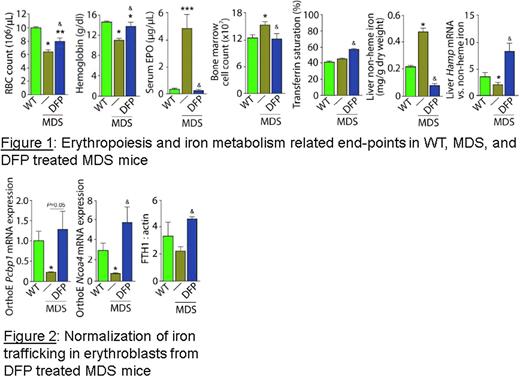Abstract
Myelodysplastic syndrome (MDS) is a heterogeneous group of bone marrow stem cell disorders characterized by ineffective hematopoiesis and cytopenias, most commonly anemia. Patients are treated with periodic red cell (RBC) transfusions, resulting in iron overload. Iron overload in MDS patients correlates with decreased survival, yet despite the availability of effective, safe, and orally administered iron chelation therapy, the treatment of iron overload in MDS remains controversial. The TELESTO trial, using deferasirox in low risk MDS patients, revealed an increase in event-free survival without impacting overall survival, hemoglobin, or RBC transfusion requirements [Angelucci Ann Int Med 2020]. However, iron chelators have different affinities for iron relative to transferrin; deferiprone has the lowest affinity of available iron chelators [Sohn Blood 2008], consistent with its ability to increase hepcidin expression in mice [Schmidt Am J Hematol 2015; Casu haematol 2016]. We hypothesize that deferiprone (DFP) impacts systemic and cellular iron distribution to enhance erythropoiesis in MDS. To test this hypothesis, we employed a highly penetrant well-established mouse model of MDS, NUP98:HOXD13 fusion transgenic mice. These MDS mice exhibit hypercellular marrow, increased apoptosis in the bone marrow compartment, and impaired survival relative to control; a proportion of mice progress to acute leukemic transformation after 7 months of age [Lin Blood 2005]. Using MDS mice, we further characterize parameters of iron trafficking in erythroblasts, evaluate the effects of DFP on erythropoiesis and iron distribution, and provide correlatory evidence in stem and progenitor cells from MDS patients. MDS mice were treated at 5 months of age with 1.25 mg/mL DFP in the drinking water for 4 weeks and compared with untreated MDS mice. Our results characterize an iron overload phenotype with aberrant erythropoiesis in MDS mice, reversed in DFP-treated MDS mice (Figure 1). Specifically, DFP leads to a redistribution of iron from liver and spleen to increase serum iron concentration and transferrin saturation, increased hemoglobin and RBC concentration in circulation, and normalized hepcidin responsiveness to iron. While MDS mice exhibit relatively decreased WBC count, no changes in WBC count are observed in DFP-treated MDS mice. Importantly, serum erythropoietin (Epo) concentration, splenomegaly, expanded erythropoiesis and erythroblast differentiation in the bone marrow are normalized in DFP-treated MDS mice. As expected when erythropoiesis is reversed, erythroblast expression of Fam132b (erythroferrone) is suppressed but no changes in STAT5 or AKT signaling, pathways downstream of Epo, are evident in DFP-treated MDS mice. These findings suggest that the expected changes in signaling downstream of Epo are unaffected by DFP administration, implicating possible changes in erythroblast Epor expression in DFP-treated MDS mice. We used sorted bone marrow to evaluate Epor expression in progressive stages of terminal erythropoiesis and demonstrate decreased Epor expression in later stage bone marrow erythroblasts from MDS mice, normalized in DFP-treated MDS mice. These findings provide evidence that increased Epor expression is a potential mechanism by which DFP leads to enhanced Epo-responsiveness and enhanced erythroblast differentiation despite decreased serum Epo concentration in MDS mice. In addition, we demonstrate for the first time increased ferritin concentration and normalized Tfr1, Pcbp1 and Ncoa4 expression in late stage erythroblasts from DFP-treated MDS mice, evidence of aberrant iron trafficking in MDS erythroblasts and their normalization with DFP treatment (Figure 2). Importantly, this effect is not observed in DFP-treated WT mice. Our data also provides evidence that reversal of ineffective erythropoiesis in DFP-treated MDS mice occurs independently of effects on erythroblast apoptosis. Finally, we confirm increased expression of genes involved in Epo-mediation as well as iron uptake and trafficking-Epor, Fam132b, Tfr1, Pcbp1 and Ncoa4-in stem and progenitor cells from MDS patients. Taken together, our findings provide evidence that erythroblast-specific iron metabolism is a novel potential therapeutic target to reverse ineffective erythropoiesis in MDS and provide a rationale for exploring the effect of DFP in patients with low risk MDS.
Disclosures
Verma:Jannsen: Consultancy, Research Funding; Bakx Therapeutics: Consultancy, Current equity holder in private company; BMS: Research Funding; Stelexis Therapeutics: Current equity holder in private company, Honoraria; Throws Exception: Current holder of stock options in a privately-held company; Medpacto: Research Funding; Novartis: Consultancy; Prelude: Research Funding; Ionctura: Research Funding; Curis: Consultancy, Research Funding; Eli Lilly: Research Funding. Ginzburg:Repare: Research Funding; Ionis: Consultancy; Takeda: Consultancy; Dexcel: Consultancy; Protagonist: Consultancy, Research Funding.
Author notes
Asterisk with author names denotes non-ASH members.


This feature is available to Subscribers Only
Sign In or Create an Account Close Modal